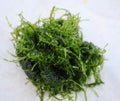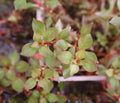Pruning and Propagating the Red Root Floaters
One of the most crucial aspects of red root floater maintenance is pruning. As the dissemination is so widespread, the growth pattern might very well spiral out of control!
Make it a habit to trim overgrowth. Pay attention to the leaves that are dripping with water. Also, you can pinch off leaves that are about an inch long.
The plant should be regularly pruned. The leaves on top will become crowded if you let the plant grow for an extended period of time without interference. Not only is this bad for the plant, but it might also diffuse too much light, which would be harmful to life below.
Get some inexpensive pruning shears to do the task. Just cut the leaf in half at the base, then discard the clippings away from the tank. Clippings shouldn't be left behind because they will decompose and drastically alter the water's quality.
Tank Mates
This plant has a lot of potential for improving any tank! The majority of fish will enjoy the coverage and effect the plant has on the water. There are a few exceptions, though.
Fish that enjoy natural cover and light diffusion respond best to the red root floater plant. It's advisable to stick with smaller aquatic species due to their rapid spread. A serious risk to one's health and safety exists when larger fish become entangled in the roots.
A good suggestion is to stay away from fish that might mistake the plant for food. Red root floaters are notoriously ruined by goldfish and oscar fish.
Thankfully, the list of fish and invertebrates that get along is much longer. The following suitable tank companions can coexist peacefully with the red root floater plant:
- Tetras
- Betta Fish
- Danios
- Molly Fish
- Platy Fish
- Pygmy Cory Catfish
- Crayfish
- Otocinclus
- Red Cherry Shrimp
- Freshwater Crabs
- Amano Shrimp
- Ghost Shrimp
- Ramshorn Snails
- Bamboo Shrimp
- Japanese Trapdoor Snails
- Malaysian Trumpet Snails
Propagation
Red root floaters can be propagated in a number of different ways.
The red root floater can spread organically through seed, just like many other plants. When the flowers blossom and become fertile, this happens. The new plant that emerges as a result of this incident can be readily removed.
It is lovely to see plants naturally bloom and produce seeds. But it's also extremely uncommon. To cause it, the environment must be perfect. The majority of plants spread through their roots.
Little "daughter" plants may sprout out close to the larger ones. You can observe a horizontal rhizome root that sprouts from the main stalk if you look beneath the surface. Snip the root and plant it somewhere else to reproduce the plant.
The last method is stalk propagation. If you need to scale back a larger plant, this method is great.
Between a group of leaves and a root, cut the plant's stem. The clipped portion will regenerate into a new plant when moved to a different tank.
Final Thoughts
As you can undoubtedly tell, anyone can take care of red root floaters. You can add this plant to your tank without needing to be an expert aquarist or aquascaping specialist; just pick it up!
If there is anything that was not covered in the care guide that you have questions about, please contact us. We're delighted to be of assistance!
















